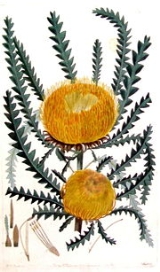
Banksia formosa
Encyclopedia
Banksia formosa, commonly known as Showy Dryandra, is a shrub
endemic to Western Australia
. It was known as Dryandra formosa until 2007, when all Dryandra species were transferred to Banksia
by Austin Mast
and Kevin Thiele
.
An assessment of the potential impact of climate change
on this species found that its range is likely to contract by between 50% and 80% by 2080, depending on the severity of the change.
.jpg)

Shrub
A shrub or bush is distinguished from a tree by its multiple stems and shorter height, usually under 5–6 m tall. A large number of plants may become either shrubs or trees, depending on the growing conditions they experience...
endemic to Western Australia
Western Australia
Western Australia is a state of Australia, occupying the entire western third of the Australian continent. It is bounded by the Indian Ocean to the north and west, the Great Australian Bight and Indian Ocean to the south, the Northern Territory to the north-east and South Australia to the south-east...
. It was known as Dryandra formosa until 2007, when all Dryandra species were transferred to Banksia
Banksia
Banksia is a genus of around 170 species in the plant family Proteaceae. These Australian wildflowers and popular garden plants are easily recognised by their characteristic flower spikes and fruiting "cones" and heads. When it comes to size, banksias range from prostrate woody shrubs to trees up...
by Austin Mast
Austin Mast
Austin R. Mast is a research botanist. Born in 1972, he obtained a Ph.D. from the University of Wisconsin–Madison in 2000. He is currently an associate professor within the Department of Biological Science at Florida State University , and has been director of FSU's since August 2003.One of his...
and Kevin Thiele
Kevin Thiele
Kevin R. Thiele is curator of the Western Australian Herbarium. His research interests include the systematics of the plant families Proteaceae, Rhamnaceae and Violaceae, and the conservation ecology of grassy woodland ecosystems...
.
An assessment of the potential impact of climate change
Climate change
Climate change is a significant and lasting change in the statistical distribution of weather patterns over periods ranging from decades to millions of years. It may be a change in average weather conditions or the distribution of events around that average...
on this species found that its range is likely to contract by between 50% and 80% by 2080, depending on the severity of the change.
External links
.jpg)


